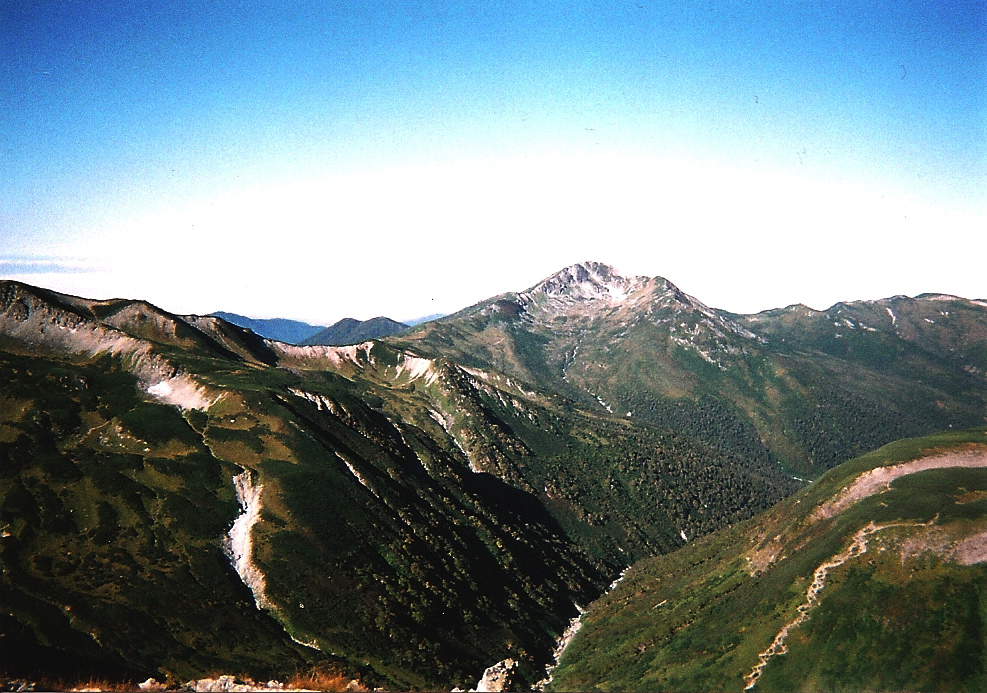This blog post was written back in 2009. For the latest information about this hike (including color photos and maps), please consider purchasing my guidebook to the Japan Alps.
Mt. Warusawa is the 6th tallest peak in Japan and the gateway to the southern portion of the Minami Alps. Its remote location and huge elevation gain make it a must-climb for burgeoning alpinists. The peak is also goes by the name of Mt. Arakawa (荒川岳) so don’t be confused – they are the same mountain.

The hike: Most people start and finish this hike at Sawara-jima, knocking off both Mt. Warusawa and Mt. Akaishi in the process. Allow 3 days to complete this tough but scenic route. From the bus stop at Sawara-jima, continue hiking north along the paved forest road for about 10 minutes until reaching a large, green, steel bridge. The trailhead is on the left, just before you cross the bridge. The path is relatively flat for the first few minutes or so, until crossing a large suspension bridge over the river. The bridge is really narrow and not for those with acrophobia. After crossing the river, the trail winds its way through a scenic forest for about an hour and a half or so, before meeting up with a gravel forest road. Cross this road and head up a metal staircase built into the hillside, marked with a 千枚小屋 signpost. This is where the true climb begins, as you’ll start climbing making some significant gains in altitude on a well-worn trail through a beautiful virgin forest. Unfortunately, you’ll cross the forest road again after about 45 minutes and will actually be running parallel to the road for most of the way (though it is out of sight). Keep climbing steadily another hour or so and you’ll reach a flat area called Shimizu-daira (清水平), which has a water source. Fill up on water here, as you’ve still got a few hours of hiking left before reaching your home for the night. There’s only one way to go, which is up, up and then up again. About a half hour after leaving the water source, you’ll pass through another marshland, where the views will start to open up. If the weather is clear then you can see both Mt. Akaishi and Mt. Warusawa rising high across the vast valley to your left. You’ll be about 2100m above sea level, but you’ve still got another 500m or so before reaching the hut. Your next landmark will be a small pond on your right, and you’ll soon cross over a set of cables running overhead, which are used to haul supplies to the nearby mountain hut. Continue hiking through the primeval silver fir forest and eventually you’ll arrive at Senmai hut (千枚小屋) and campsite. The hut is open from mid-July to mid-October and costs 8000 yen with 2 meals or 5000 yen without. Camping runs 600 yen per person. Additionally, the 2nd floor of the hut is open out of season and won’t cost you a thing (but you’ll need your own sleeping gear and food). According to the map, it should take about 7 hours for the 10km, 1500m vertical ascent from Sawara-jima to the hut, but you can do it in less time if you’re fit and traveling light. The next day continue on the same trail to the top of Mt. Senmai (千枚岳). Soon after leaving the hut, you’ll pop out of the tree line, and will be there the rest of the day. The trail will become quite rocky, and the views are nothing short of spectacular. From this vantage point, you’ve got an unobstructed view of the entire Minami Alps, which is rare since the towering peaks usually conceal the larger ones behind. Anyway, stay on the ride line for about 45 minutes, and you’ll reach your first 3000m peak of the day, called Mt. Maru (丸山). A short up-and-down traverse later, and you’ll be sitting on top of Mt. Warusawa, the target peak. From here, you can retrace your steps back to Sawara-jima, but I really recommend staying on the ridge line a few more days. Get ready for a huge drop down to a saddle on the other side of Warusawa and a strenuous climb up to Nakadake (中岳), where you’ll find an emergency hut. There are a lot of ptarmigan in the saddle between the two peaks – I was luck enough to see a family with recently hatched chicks. The emergency hut at Nakadake is another possible place to stay, but be warned that it’ll cost you a jaw-dropping 4500 yen to stay in a place with no water or food! This hut is shut tight in the off season, and camping is prohibited in the vicinity. The astronomical costs are due to a monopoly by the Tokai Forest corporation, which owns every single hut on the route. Just behind the hut, you’ll find the summit of Mae-dake (前岳), where you’ll have to make a decision. Turn left to descend to Arakawa hut (荒川小屋) and the gargantuan climb up to Mt. Akaishi. Turn right if you’d like to head towards Mt. Shiomi, which will take another 2 days to reach. Click here for some great photos of the entire Warusawa/Akaishi loop.
When to go: This hike can be done from mid-July to the end of August, when the bus to Hatanagi dam is running. If you’ve got your own transport then you can attempt much earlier or later in the season. A winter ascent may able be possible with the right equipment and experience.
Access: From Shizuoka station (静岡駅), take a bus bound for Hatanagi-daiichi Dam (畑薙第一ダム) and get off at the dam. Change to a shuttle bus bound for Sawara-jima Lodge (椹島ロッジ). Please note that the bus to Hatanagi-daiichi has been discontinued as of May 31st, 2008, and has been replaced by a seasonal bus running only from July 19th to August 31st. Click here for the bus schedule for the bus from Shizuoka to the dam and here for the shuttle bus schedule from the dam to the lodge.
Level of difficulty: 5 out of 5 (elevation change ~2000m)










